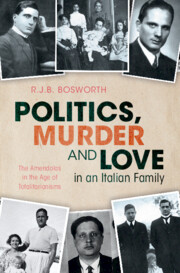Book contents
- Politics, Murder and Love in an Italian Family
- Frontispiece
- Politics, Murder and Love in an Italian Family
- Copyright page
- Dedication
- Contents
- Figures
- Preface
- Abbreviations
- Introduction
- 1 Political Violence and the Amendolas, Father and Son
- 2 The Rise of Giovanni Amendola, 1882–1919
- 3 Giovanni Amendola
- 4 Nelia Pavlova
- 5 Giorgio Amendola, 1907–43
- 6 Giorgio Amendola and a National Road to Socialism and the End of History
- Conclusion
- Afterword
- Notes
- Select Bibliography
- Index
1 - Political Violence and the Amendolas, Father and Son
Published online by Cambridge University Press: 13 January 2023
- Politics, Murder and Love in an Italian Family
- Frontispiece
- Politics, Murder and Love in an Italian Family
- Copyright page
- Dedication
- Contents
- Figures
- Preface
- Abbreviations
- Introduction
- 1 Political Violence and the Amendolas, Father and Son
- 2 The Rise of Giovanni Amendola, 1882–1919
- 3 Giovanni Amendola
- 4 Nelia Pavlova
- 5 Giorgio Amendola, 1907–43
- 6 Giorgio Amendola and a National Road to Socialism and the End of History
- Conclusion
- Afterword
- Notes
- Select Bibliography
- Index
Summary
This chapter describes three major violent events in the Amendolas’ lives. The first was a squadrist attack on Giovanni in central Rome on 26 December 1923. By the following summer, after the Fascist kidnapping and murder of the socialist Giacomo Matteotti, Amendola had become the leader of the Aventine Secession and thus head of the respectable opposition to the Fascist regime. What resulted was a still more vicious beating he was given in Tuscany on the night of 20–21 July 1925. Giovanni died of his injuries in Cannes in April 1926. His tomb carried the message ‘Here lies Giovanni Amendola, waiting’. Even Mussolini was willing to state that Giovanni was the noblest of his enemies (as well as the most menacing). Giovanni’s teenage son, Giorgio, watched his father’s persecution and decided, after 1926, that only communism offered a genuinely strong opposition to Fascism. He therefore joined the party in 1929. By 1943–4, he was a reasonably senior figure in the PCI, and he became responsible for its fighting resistance around Rome. Action culminated on 23 March 1944, with the attack on German soldiers in the Via Rasella.
- Type
- Chapter
- Information
- Politics, Murder and Love in an Italian FamilyThe Amendolas in the Age of Totalitarianisms, pp. 4 - 32Publisher: Cambridge University PressPrint publication year: 2023

